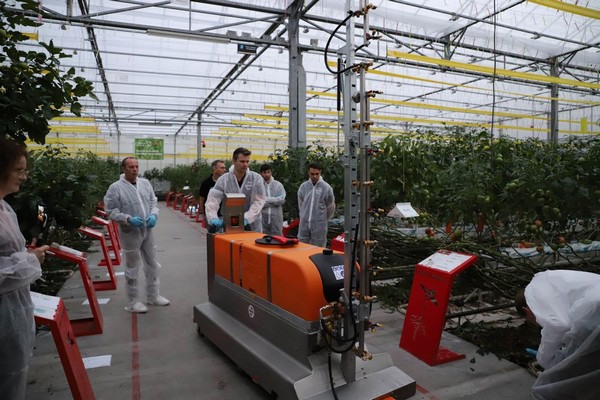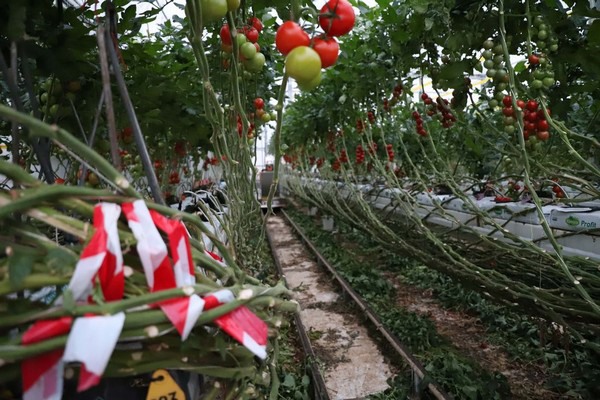With the number of challenges increasing, growers are constantly looking for new strategies, resources, and technology to protect their crops sustainably and effectively. Manufacturers and suppliers are working to support them in their quest, using new products, technologies, and decision support tools to their best advantage.
‘Working together on innovation and knowledge transfer’
Certis Belchim is collaborating with equipment manufacturer, Berg Hortimotive, and innovations specialist, HortiKey (both part of the Royal Brinkman Group), to improve the efficacy of crop protection programs in protected cropping, including ornamentals.

“Regulatory challenges are huge and are increasing as a result of policy in our country and in Europe,” says Louis van den Berg of HortiKey. “To meet the challenges, even if only partially, we need to analyze the strategies and working methods applied at company level and identify areas for improvement. Growers also need to know and understand more about this, including the most effective ways of using and applying new “green” products. We have undertaken a joint task to develop innovations and transfer knowledge, and we are focusing on that as a team.”
The innovation specialist refers to the team made up of resource producers/distributors, equipment manufacturers and the research and consultancy world. By collaborating more closely in a group context and including growers, existing knowledge can be combined and shared, innovation receives a new impetus, and the grower is provided with new opportunities to adopt sustainable strategies that provide effective pest and disease control.
“The advantage of working together is that we also learn more ourselves and can ensure that the solutions we deliver are practicable for growers,” says technical advisor for greenhouse horticulture, Aron Boerefijn of Certis Belchim. He joined Louis van den Berg of HortiKey to explain the collaboration and the innovation project that started last autumn.

Contact is essential
Boerefijn explains: “Pressure for ‘greener’ plant protection products has led to the introduction of many new products, including the Certis Belchim range of Biorationals. Most of the new agents – both green and chemical – are not actively absorbed by the crop, and contact with the disease or pest is, therefore, essential for a good result. To maintain sustainability, it is also critical that none of the product should be ‘lost’ into the soil or growing medium. This requires better-tuned equipment. Droplet size, spray angle, working pressure, and driving speed all have to be correct to get the right spray pattern. Growers, therefore, need to take onboard a whole new approach, as well as different technology. They must carefully consider in advance which disease or pest they want to control and then adjust and check the corresponding settings.”
“In practice, this does not frequently happen enough or well enough,” says Van den Berg. “We sometimes come across equipment whose settings have not been adjusted for ten years.”
Optimal spraying technique
The project concerns the optimization of spraying technology for specific crop/product combinations as a stepping stone to new, autonomous 'multiple application' systems. You have to imagine that a spraying robot, based on data collected and analyzed automatically, carries out treatments independently (preferably locally), if necessary, at several heights in the crop with different agents, in one working pass. “We have been researching this together at Tomato World,” says Van den Berg. “We have multiple-deployable systems that can apply multiple resources independently, with the right adjustment to get the resource where it needs to be, with minimal waste.”
“Work at the Certis Belchim Innovation Centre in Naaldwijk, The Netherlands, is also contributing to our knowledge.” continues Boerefijn. “The same principle applies to the production of Chrysanthemums, for example, to improve the efficiency of Bacillus Thuringiensis applications, or Lisianthus, where a normal spray boom in the greenhouse will only get the product onto the top 10cm of the crop. We are investigating the use of equipment that will spray droplets from underneath the crop to control the pests and are also looking at low mist and fogging systems, particularly for denser growth crops such as Roses or Gerbera, to ensure contact of Biorational products with the pest.”
More effect, less means
The project kicked off with a survey, as explained by Louis van den Berg: “It showed that there were major differences in working methods and settings, even between companies with the same crops. Effective and efficient spraying at the right time not only leads to better results but also to lower resource consumption and better maintenance of the biological system in the greenhouse.”
“Reality forces the chain to make smart, sustainable choices in resources and technology,” says Van den Berg. “We are therefore also looking to learn from developments in other sectors. In terms of spraying technology, arable farming, and outdoor ornamentals production has come a long way. A nice example is the electronic Hawkeye nozzle from Raven Technologies. Each individual cap is automatically controlled and fine-tuned based on driving speed and/or location. Precision spraying at any time, even when accelerating or braking in a greenhouse, becomes a lot easier with this functionality.”
In conclusion
“There are many opportunities to improve on the spraying techniques so frequently still used in protected ornamentals, and pooling our knowledge and experience, as well as using the benefits of our range of Biorational products, is helping us to develop new systems and strategies for growers, in line with the regulations and policy requirements,” concludes Boerefijn. “Knowledge transfer will enable growers to better understand the new products and the technologies that make them most efficient and will provide them with effective and sustainable solutions.”

 For more information:
For more information: